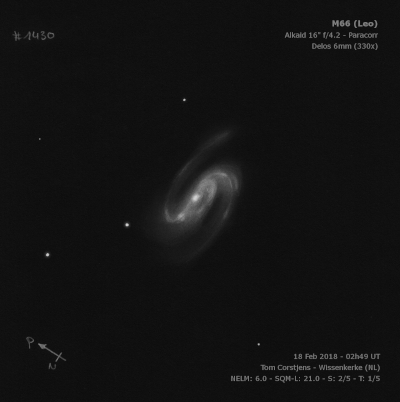
Charles Messier discovered M66 = NGC 3627 = h857 = h875, along with M65, on 1 Mar 1780. On 12 Apr 1784, William Herschel recorded "vB, mE, iF. The extension is chiefly in the direction of the meridian, and the greatest brightness near the middle. John Herschel made 4 observations, once claiming it as a new (h875), with his RA 3 minutes too large. On sweep 22 he logged "vB; vL; sbM; 3' l, 2' br; E 60° np to sf in direction of 2 stars 10m, preceding."
George Stoney sketched the galaxy with Lord Rosse's 72" on 17 Apr 1849 (Plate XXVII, fig. 16 in the 1861 publication). Features included a well defined spiral arm along the western side and arcs within the main body that correspond with brighter sections of spiral arms. The 31 Mar 1848 observation by Rosse or assistant Rambaut mentions "a little above towards the right [nf] is a dark streak; spiral, resolved well about the Nucl, but no other part. From the right, and apparently springing from the nucleus, a vF portion of nebulosity extends for nearly 15', gradually melting away." A schematic in the 1880 publication shows the beginning of two arms on the eastern side and a long, thick arm on the western side.
William Lassell also sketched M66 using his 48-inch from Malta on 21 Apr 1862, though misidentified it as M65. The galaxy was drawn as more irregular than spiral, though the primary arm on the west side is clearly sketched, along with a dark gap between it and the core. Also a loop was sketched on the north side corresponding with part of the eastern arm as well as a continuation of the western arm as it curls towards the core.
300/350mm - 13.1" (4/24/82): bright elongated core, stellar nucleus. A diffuse spiral arm extends south and a second short arm extends to the east. A dark patch is visible just east of the nucleus.
400/500mm - 17.5" (1/31/87): very bright, large, elongated N-S, 5'x3', bright elongated core contains a stellar nucleus. Two spiral arms are visible although the western arm is more prominent.
900/1200mm - 48" (4/13/10): this showpiece galaxy stretches 7'x3' N-S. The central region is dominated by a prominent, 3'x1.2' central bar that is elongated NNW-SSE. The central region has a mottled, irregular surface brightness and increases gradually towards the center and then suddenly to a very bright, stellar nucleus. A very faint star or HII knot was seen at the very north tip of the bar [confirmed as #44 in Hodge's "Second Survey of HII regions in Galaxies", ApJS, 27, 113 (1974)]. The longer, better defined arm is attached at the north end and sweeps directly south along the western flank of the galaxy for a total length of ~5'. The western edge of this arm is very well defined as it fades to the southern tip, though the inner edge merges with the glow within the central region. The arm and bar are brightest where they join at the north end of the central region. The second spiral arm is attached at the south end of the bar and shoots north on the eastern side of the galaxy. This arm fades after a shorter distance, so is not as prominent, but is brightest at the root where it emerges from the bar. A mag 9.8 star lies 3' NW of center at the outer edge of the halo.
Notes by Steve Gottlieb